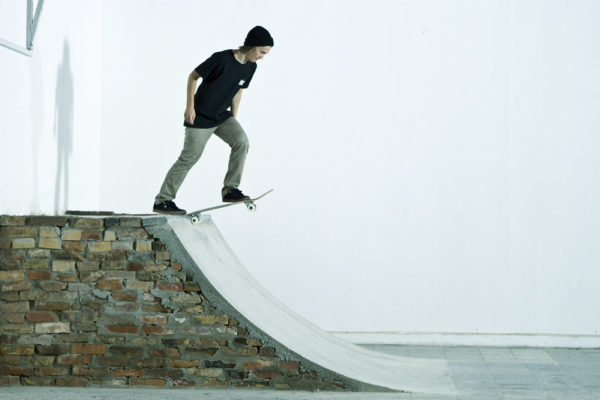Drop-in is one of the most difficult skateboard tricks you may see in every skatepark. Skateboarders who wish to perform this trick must be very confident and courageous in their skills. If you wish to show off your skills, then this drop-in trick is perfect to do that. Let’s follow these steps:
Step #1: Check out the skatepark you are going to land this trick
If you haven’t gone to play on a skatepark before, you’d better warm up with some simple tricks around the ramp bottom to get familiar with the terrain first. Put helmets, knee pads, elbow pads, and wrist pads on if you want to continue skateboarding the next day. As I said before this is the most difficult trick, you can fall at any time at first tries.

So be equipped! Kids rarely can do this trick, but I know some boys show their talents from a very young age, so nothing parents can do but buy them the best skateboard for kids, all you can refer to this “how to choose a skateboard for kids” article.
When you are familiar enough with the bottom, head to the top of the ramps. Once the familiarization process has been completed, move on to the next step.
Step #2: Determine the ending point of the trick
It is very important to know where you are going to land. Before you start, stand at the top of the ramp and look at it carefully to see whether it ends or join with another ramp, and is it flat or uneven? etc. It is safer to slide on a flat ramp, remember that. But don’t worry, there isn’t a case that has been recorded as serious injuries during the drop-in performance.
Watch out for other skateboarders and obstacles because sometimes you just pay attention to your skateboarding, otherwise, you will end up smacking with others.
Step #3: set your skateboard tail
First, put the tail of your skateboard on the copping, then hang your back wheels on the top edge of the ramp. Use your back leg to keep the board up. Your foot should be in a straight line across your skateboard. Now, the front wheels are holding up on the air, try to keep the balance to get ready to drop in.
Step #4: Place your front foot
The front foot will be placed over the front truck when you are in a balanced position. You can omit this step and move on to the next one.
At this point, if you find skateboarding too difficult, you can switch to play cruiser skateboard, it is much easier. These best cruiser skateboards under $100 are friendly to your budget, and I ensure you will have as interesting experiences with a cruiser as with a skateboard. Let’s try it out!
Step#5: Drop-in
This is when everything is set, it’s time to end this trick. Stomp your front foot down till you see the front wheels hit the ramp, then lean your body on the ramp. You may feel scared on this step. Once you fire, you can not come back. Make a commitment to yourself.
People who failed this trick weren’t committed enough, so they fell. Trust yourself, believe that you can do it, and think about your goal. Stay focus for 100%, one minimal mistake can lead you to ground by face. If you are successful in the first try, it will be much easier next time.
Your self-confidence is very important in skateboarding. Think about your goal, always whisper “ I can do it, I can do it…” and you can do it. Trust yourself and trust your board, too.
Step#6: Skate off
Congratulation guys! you did very well. And if you failed for the first time, I still congratulate you because at least you will learn something from the first try. Keep practicing, try it several times, and don’t forget the magic words“ I can do it”. I’m so proud of you.
See many articles about skateboarding by Skateadvisors on Facebook.